(This booklet was written by Flight Lieutenant Bill W R Lambert, (who sadly died
in May 1998) and Flight Lieutenant Robin R A Brown and originally printed as a
booklet in August 1967. The copyright belongs to the Authors and the History
must not be downloaded or used without their written permission. I have, at last,
managed to track down Robin Brown, thanks to Andrew Thomas, and Robin has
kindly agreed to allow me to keep his history on our web site.
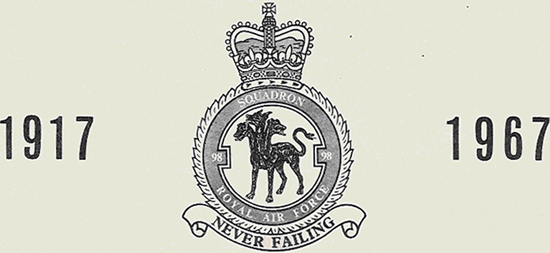
A SHORT HISTORY OF
No.98 SQUADRON, R.A.F.
BY FLT. LT. W.R. Lambert, R.A.F. & FLT. LT. R.A. Brown, R.A.F.
Aug .1967
CONTENTS
THE FIRST WORLD WAR
THE SECOND WORLD WAR
THE POST-WAR PERIOD
APPENDICES
'A' Officers Commanding No 98 Squadron
'B' Squadron Locations
'C' Squadron Aircraft Types
'D' Aircraft Specifications
'E' Maps of Theatres of Operation
THE FIRST WORLD WAR
The effectiveness of the German daylight raids over England in the summer of 1917
resulted in an outcry by the British public for better protection at home and a British
bombing force capable of inflicting similar punishment on the Germans. On the
21st June 1917, it was decided to increase the number of flying squadrons in the RFC
from 108 to 200, the majority to be bomber squadrons.
On 30th August 1917, No 98 Squadron, RFC was formed at Harlaxton, Lincolnshire,
from a nucleus flight from No 4 Training Squadron, the squadron moving to Old Sarum
the same day. The squadron was going to be equipped with DH 9s, the successor to the
DH 4, but due to the delays in the production of the new Beardmore-Hallford-Pullinger
engine, the aeroplanes were not received until February 1918. Meanwhile, they flew
mainly DH 4s and some FK 8s, BE 2c's and BE 2e's.
A new influx of observers arrived on 25th February 1918 mostly ex-cavalry from the
Lancers, Huzzars and Yeomanry, and by 14th March 1918 the squadron had eighteen aero-
planes complete with their guns.
Mobilisation
98 Squadron mobilised on 1st March 1918, and on the 23rd March 1918 the ground personnel
embarked for France, but were brought back on 28th March 1918 to Lympne, in Kent. On 25th March 1918
the aircraft flew down to Lympne and despite several accidents the squadron and eighteen
aeroplanes left Lympne for St Omer on 1st April 1918, the birthday of the Royal Air Force.
Two days later, the squadron flew to Clairmarais an airfield only a few miles away.
Battle of the Lys
On 9th April 1918 the Battle of the Lys began and with it the first great battle fought by
the new Royal Air Force. The squadron began operations on 11th April 1918 detailing
fifteen aircraft to bomb Wervicq. One crashed on take-off and two returned with engine
trouble, the remaining twelve dropped twenty-four 112-lb bombs and fired 1170 rounds
at captive balloons and ground targets. No enemy aeroplanes were seen and no aircraft
was damaged by enemy action. The next day the squadron really found itself involved
in the war. It was the day that Haig issued his famous "Backs to the Wall" order. 98
was sent to attack the German lines of communication at Wervicq, Quesnoy, Comines,
Frelinghein and Haubourdin in the morning and the Merville area in the afternoon.
The squadron dropped a total of seventy-seven 112-lb bombs on enemy troops and
transport. Headquarters congratulated 98 Squadron on their splendid performance.
That evening due to the advance of the Germans, the squadron moved to Alquines, an
airfield 22 kilometres west of St. Omer.
The following message of congratulation was issued on 18th April 1918:
"The General Officer Commanding, Royal Air Force in the Field, wishes me to
express his thanks and good wishes to the Officers, NCOs and men of No 98
Squadron for their fine work at the start of the present battle. He hopes that the
same spirit of doggedness, determination and sacrifice will still be maintained by
the Squadron as a whole in the battles that are to come, and looks to No 98 Squadron
to keep up the reputation it has already gained never failing.
(signed)
H. MacD, O'Malley,
Major
Commanding No 98 Squadron
Royal Air Force
April 18th, 1918 In the Field"
The last two words "Never Failing" were in 1937 to form the motto beneath the squadron
crest.
During the following days, many targets were attacked mainly at Armentieres and
Gheluwe, but also Bailleul, Merlin and Rouliers.
On 25th April 1918 in the afternoon four aeroplanes took off to attack Gheluwe. One
returned with rigging trouble. The remaining three were attacked by seven Pfalz scouts
and C. 6079 was shot down. The crew, Lt C. J. Gillan and Lt W. Duce, were taken
prisoner. This was the first Squadron loss to the enemy.
The following is an extract concerning this episode from the diaries of 2nd Lieutenant Cecil Whyte, an Observer with 98 Sqn:
"Thursday, April 25 1918
Up at 4 a.m, and once again our engine konked at 9000'. These BHP's are not worth any more than the metal in them. Was intimated that our feet must he cold - At noon we found the valve spring again broken, but did not notice any apology.
After lunch seven Huns pounced on three of A flight behind the enemy lines and brought down Gillan and Duce, whether they are killed we do not know. Stanfield & Dublur crawled back with their machines riddled with bullets.
At 7 p,m. C flight left to bomb Menin. We started 15 minutes later but could not find the formation. At 8 p,m, we crossed the line alone and bombed Wernicq with a 230. I never had my eyes more widely opened. We saw Huns in the distance but put our nose down and went at 140 m.p.h. Reaching Lumbres we ran into thick fog and tried to land in a ploughed field, we hit a sunken road and crashed slightly. Officers from a Prisoners of War camp took us in, gave us a good dinner and made us at home until our tender arrived at midnight for us. We learned that five of our machines are still missing but some have been located behind our lines.
The Huns are advancing again and rumor has it that Kemmel and Mount Kemmel have been taken by the Boche - also Dranoutre and Locre. I wonder what will become of poor Len's grave in the little churchyard in Locre."
Operations against Ostende
On 25th May 1918, the Squadron moved from Alquines to Coudekerque about two miles
south of Dunkirk. The targets for the next two weeks being the docks at Ostende and
Bruges to destroy the U-boats at their moorings.
Attacks on the Railways
Following an attack on the airfield the night before when one Airman was killed and
several aeroplanes wrecked. the Squadron left on 6th June 1918 for Ruisseauville. During
the weeks to come, many railway junctions were attacked in the Courtrai and Tournai
regions. Over one hundred 112-lb bombs were dropped from heights varying between
11,000' to 14,000'.
On 11th July 1918, 98 Squadron sent three aeroplanes to Don railway junction, Fourteen
Pfalz scouts were encountered from 13,000', two were destroyed by 2/Lt F. C. Wilton,
pilot, and 2/ Lt E. V. Austin, Observer, before Lt Austin was killed. Capt O. C. W.
Johnsen was flying with his new observer, Capt G. H. P. Whitfeld and their Combat
Report is now preserved in the Squadron album.
Army Form W. 2345
Combats in the Air.
______________
Squadron : 98. Date : 11-7-18
Type and No. of Aeroplane: D.H.9.1731 Time : 7-50 a.m.
7237.
Locality : Don.
Armament : Vickers. 1 Lewis
On each. Duty : Bombing.
Pilot : Capt, O.C.W. Johnsen.
2/Lt, C. Richmond. Height : 13000 feet.
{Destroyed......
Observer : Capt. G.H. Whitford. Result {Driven down out of control...
Sgt. F. Sefton {Driven down.
______________
Remarks on Hostile Aircraft :--Type, armament, speed, etc.
14 PFALZ SCOUTS.
Narrative.
Capt. O.C.W. Johnsen's Statement:- Immediately bombs had been
dropped I saw 7 PFALZ SCOUTS coming straight for me about 100 yards away.
I fired 20 rounds at the leader from my front gun who was last seen
going down completely out of control with a large cloud of smoke coming
from his machine. I was unable to follow him down as I was attacked by
other E.A. and my observer's gun had jammed.
W Johnsen..Capt.
Sgt. Sefton's Statement:-
I opened fire on one E.A. which was approaching my tail. I fired
two magazines into it. He immediately nose-dived and then went into a
spin. E.A. was still spinning at less than 1000 ft from the ground. I
was unable to follow it further as I was attacked by another E.A.
Sgt.
In the Field,
11-7-18. Commanding 98 Squadron, R.A.F.
The Second Battle of the Marne
Due to increased German offensive, General Foch asked Haig for fighter and bomber
squadrons to reinforce the French air service, and so, on 14th July 1918 98 Squadron, as part
of 9 Brigade, went south to Chailly-en-Brie.
Many attacks were carried out to stem the German offensive, often low level against
ground targets such as the footbridges over the Marne. By the beginning of August 1918 the
Germans had abandoned all their gains of May and June and, more important, the initia-
tive now lay with the Allies.
On 29th July 1918 eight DH 9s were out on line patrols and one on line recce. This was
the last operational flight over Champagne for on 2nd August 1918, the Squadron returned to
the British Front to Blangermont for the coming Battle of Amiens.
The Squadron had enjoyed the stay at Chailly more than most places, mainly because
of the proximity of Paris. A squadron tender would take the aircrew in for the evening,
then meeting them outside the Opera House in the small hours, they would reach the
airfield just in time to scramble into their aircraft for the early sorties.
The Battle of Amiens
On the morning of the 8th August 1918, the main attack on the enemy's airfields began.
In the evening, they were to switch their attacks to railway stations at Peronne and
Chaulnes.
Three aeroplanes of 'B' Flight, Capt Powell and Capt Whitfeld in D. 3078; 2/Lt
Goffe and Sgt May and Lt Carpenter and 2/Lt MacDonald took off to bomb the railway
bridge at Peronne.
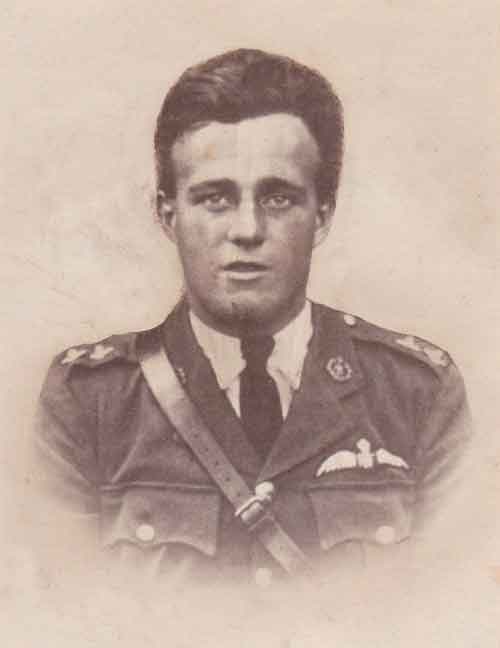 2nd Lt. Walter Goffe.
Lt Fogarty and Lt Sefton also took off at the same time but they had
to land at Villers-Bocage with engine trouble. The vic of three managed to fly for most
of the way half in and out of cloud, but near their objective they suddenly emerged into
bright sunlight. Almost immediately they were pounced on by enemy fighters. One
DH 9 darted smartly back into cloud but two Fokker D VIIs and an Albatross scout
attacked Powell and Whitfeld. D. 3078 was a. three-gun machine, with an extra Lewis
gun (the 'Wind--up Gun') firing downward under the rear cockpit. The attacks by the
Fokkers shot away the aircraft's controls and the drum on the rear Lewis gun was hit,
making it useless. Powell managed to force-land the aircraft safely despite the fact
they still had a full load of bombs on.
German troops surrounded the aircraft as it came to rest and a German officer
galloped up on a horse and demanded "What is your Squadron?", but galloped away
before either of them could reply. The Germans were not to remain in doubt much
longer as to the composition of 98 Squadron as later that day the Squadron PMC was
shot down carrying all the Squadron's mess bills!
2nd Lt. Walter Goffe.
Lt Fogarty and Lt Sefton also took off at the same time but they had
to land at Villers-Bocage with engine trouble. The vic of three managed to fly for most
of the way half in and out of cloud, but near their objective they suddenly emerged into
bright sunlight. Almost immediately they were pounced on by enemy fighters. One
DH 9 darted smartly back into cloud but two Fokker D VIIs and an Albatross scout
attacked Powell and Whitfeld. D. 3078 was a. three-gun machine, with an extra Lewis
gun (the 'Wind--up Gun') firing downward under the rear cockpit. The attacks by the
Fokkers shot away the aircraft's controls and the drum on the rear Lewis gun was hit,
making it useless. Powell managed to force-land the aircraft safely despite the fact
they still had a full load of bombs on.
German troops surrounded the aircraft as it came to rest and a German officer
galloped up on a horse and demanded "What is your Squadron?", but galloped away
before either of them could reply. The Germans were not to remain in doubt much
longer as to the composition of 98 Squadron as later that day the Squadron PMC was
shot down carrying all the Squadron's mess bills!
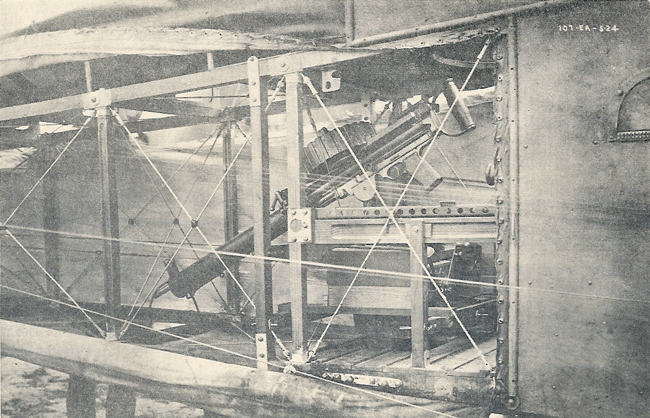
A possibly unique photograph showing a downward and rearward firing machine-gun fitted
behind the rear cockpit of a DH 9, it was unofficially known as the 'Wind-Up Gun'. The
camera is a standard 'L' Type, taking vertical photographs through the floor of the fuselage.
An incident recollected by Lt C. G. Gowing occurred soon after he joined the
Squadron while it was on the Marne. Having visited a Bristol Fighter squadron, he was
impressed with the long exhaust tubes they carried. The exhausts on the DH 9were so
positioned that after every flight, the pilot returned with one side of his face blackened
by exhaust smoke. Gowing considered that a modified exhaust would be just the thing.
His fitter procured a Bristol Fighter exhaust and fitted it on the DH 9. The next day
the Squadron got airborne and, as usual, climbed to the west over the Channel to obtain
sufficient height before turning back over the front lines. Over the Channel it was the
practice to warm the front and rear guns. When Lt Gowing fired his front gun there
was a frightful noise and the engine stopped. The fitter had located the new extended
exhaust so that it passed right in front of the machine gun, deflecting the first few
rounds straight into the engine. Having, in effect, shot himself down, Lt Gowing was
obliged to do a forced landing.
YOU'RE ONLY A PBO
(Tune: 'Bachelor Gay' from 'The Maid of the Mountains')
"When you get in the old machine to start on a damned OP
You cover yourself with tons of clothes and they're all of them NBG
The pilot sits near the engine's warmth, his body with heat aglow,
Whilst you must stand in the back and cuss
Till the ice on your whiskers stall the bus,
You're only a PBO, yes, only a PBO".
-------------------------------------------
Bombing raids continued during these weeks on various targets in the Arras, Cambrai,
St Quintin area. The DH 9s were now being given fighter escorts to cover their poor
performance and those that had to leave the formation with engine troubles.
On 3rd September 1918, eighteen 112lb bombs were dropped on Cambrai railway junc-
tion from 12,500'. Nine direct hits were registered; two buildings set on fire and three
trains hit. The formation was attacked by six Fokkers and three of them were driven
out of control, but 2/Lt Halliday, an observer, was killed. Lt Ingram and 2 /Lt Dennits
were shot down and later reported dead. The same target was to be attacked again by
98 Squadron in the Second World War (See Page 13).
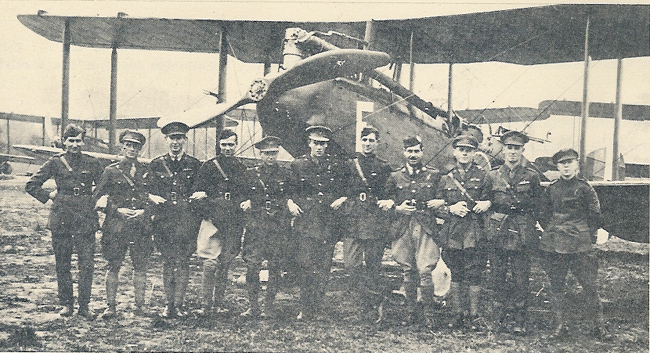
'A' Flight at Blangermont in August, 1918
Lined up in front of DH 9 'E'' D.3053 are L to R~ Lt. F. J. Fogarty; - Lt J. N.
Brown; Lt W. V. Thomas; Capt R. V. James ('A' Flt Cdr); Capt A. W. B. Becher;
Lt F. C. Wilton; Capt G. H. Gillis; - Lt H. V. R. Roberts-Taylor; Sgt -.
Photo by Rev. F.J. Keble
Capture of the Hindenburg Line
During the months of September and October 1918, there were numerous raids on the
enemy's airfields, troops and lines of communication. As the British army rolled east-
wards, the Squadron moved forward to Abscon, about ten miles west of Valenciennes, the
airmen being billeted in an old nunnery.
30th October 1918 was a bad day for 98 Squadron when the German air force made one of
its most determined defensive efforts. The Squadron whilst bombing Mons was attacked
by thirty enemy aircraft, mostly Fokkers. 1,475 rounds were loosed off by the DH 9s
and four enemy scouts fell in flames. The fighter escort of Sopwith Dolphins from 19
Squadron claimed five more. The Germans fought all the way back to the line, some
twenty miles, and four DH 9s fell behind enemy lines, two more crashing on landing.
The RAF lost 41 aircraft that day, but 67 German fighters were also shot down.
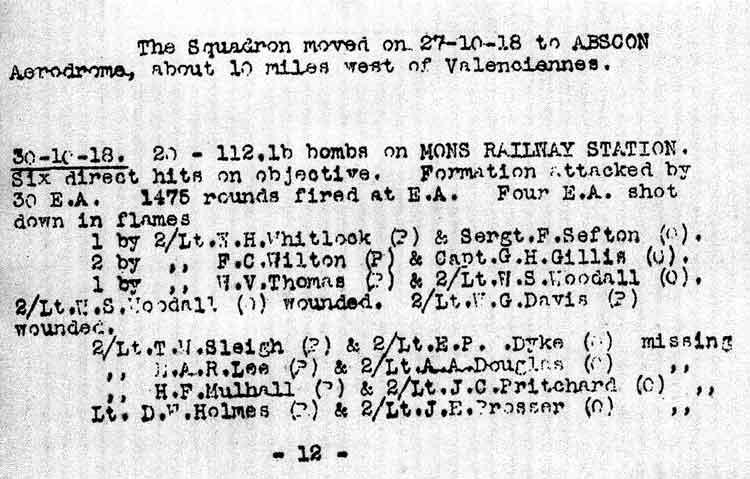 During the first week in November 1918 only a few reconnaissance flights were carried
out. On 8th November 1918, Capt Johnsen and 2/Lt Thompson were reconnoitering the Mons-
Conde-Peruwelz area without having much success. They landed their aircraft about
500 yds southwest of Peruwelz, between advancing British and retreating Germans, and
spoke to some inhabitants. They said that large numbers of retreating German infantry
and artillery had left that night and early morning.
At 11 a. m. on 11th November 1918, the Armistice was signed with Germany and the
war was over. 98 Squadron stayed in France until 20th March 1919, acting mainly as a
holding unit for the disbanding DH 9 squadrons.
On 20th March 1919, the Squadron returned to England, to Shotwick, near Chester, and
on 24th June 1919, was disbanded.
98 Squadron claimed 40 enemy aeroplanes destroyed, 35 'driven out of control', and
4 'driven down'. One enemy kite balloon was destroyed in flames and another driven
down. The Squadron lost 13 aeroplanes definitely shot down in enemy lines, another 13
missing; ten more crashed or crash-landed in our lines and about 31 were damaged or
destroyed due to accidents.
Nineteen aircrew of 98 are known to have been killed, 22 were reported missing, 14
were wounded, 13 injured in crashes, 16 taken prisoner and 5 were accidentally killed.
Five DFCs were awarded, one DFM, four Croix de Guerre, one Medaille Militaire
and one MSM.
Whilst the Squadron operated in France from April 1918 to the beginning of November 1918,
over 163 aeroplanes were used, the average lasting about one month. Something like
180 aircrew passed through the Squadron during this time, reflecting the more serious
loss of life and giving a 45% chance of failing to survive.
A contemporary summary of flying times up to the Armistice reads as follows:
War Flying Times Test, Practice Times Total
2, 873 hrs 826 hrs 3, 698 hrs
Bombs dropped::
20 lb 25 lb 112 lb 230 lb Total
454 70 1,209 190 84 tons 15 cwt
During the first week in November 1918 only a few reconnaissance flights were carried
out. On 8th November 1918, Capt Johnsen and 2/Lt Thompson were reconnoitering the Mons-
Conde-Peruwelz area without having much success. They landed their aircraft about
500 yds southwest of Peruwelz, between advancing British and retreating Germans, and
spoke to some inhabitants. They said that large numbers of retreating German infantry
and artillery had left that night and early morning.
At 11 a. m. on 11th November 1918, the Armistice was signed with Germany and the
war was over. 98 Squadron stayed in France until 20th March 1919, acting mainly as a
holding unit for the disbanding DH 9 squadrons.
On 20th March 1919, the Squadron returned to England, to Shotwick, near Chester, and
on 24th June 1919, was disbanded.
98 Squadron claimed 40 enemy aeroplanes destroyed, 35 'driven out of control', and
4 'driven down'. One enemy kite balloon was destroyed in flames and another driven
down. The Squadron lost 13 aeroplanes definitely shot down in enemy lines, another 13
missing; ten more crashed or crash-landed in our lines and about 31 were damaged or
destroyed due to accidents.
Nineteen aircrew of 98 are known to have been killed, 22 were reported missing, 14
were wounded, 13 injured in crashes, 16 taken prisoner and 5 were accidentally killed.
Five DFCs were awarded, one DFM, four Croix de Guerre, one Medaille Militaire
and one MSM.
Whilst the Squadron operated in France from April 1918 to the beginning of November 1918,
over 163 aeroplanes were used, the average lasting about one month. Something like
180 aircrew passed through the Squadron during this time, reflecting the more serious
loss of life and giving a 45% chance of failing to survive.
A contemporary summary of flying times up to the Armistice reads as follows:
War Flying Times Test, Practice Times Total
2, 873 hrs 826 hrs 3, 698 hrs
Bombs dropped::
20 lb 25 lb 112 lb 230 lb Total
454 70 1,209 190 84 tons 15 cwt
THE SECOND WORLD WAR
Pre-War
In 1935 the Italians invaded Abyssinia, withdrew from the League of Nations and
joined the Axis with Hitler. The following year the Spanish Civil War began and Great
Britain decided to re-arm.
No 98 Squadron reformed on 17th February, 1936, as a nucleus flight from its
parent unit, No 15 (Bomber) Squadron as part of No 1 (B) Group at RAF Abingdon.
The Squadron consisted, initially, of two officers, one SNCO and six Hawker Hind
aeroplanes.
The Hind, developed from the Hawker Hart, was yet another of the beautiful
biplanes of the era, though it showed little improvement in design over the DH 9. The
cockpits were open, the propeller was fixed pitch, the aircraft was fabric covered with
a fixed undercarriage. The engine power had more than trebled giving twice the speed
of the DH 9 at 16,000' and double the rate of climb.
On 21st August 1936, the Squadron flew to Hucknall, near Derby, having been
transferred to the newly formed No 2 (B) Group.
In the months to follow the Squadron carried on with training exercises, now having
thirteen aircraft and taking part in the mass formation fly-past at the RAF Display at
Hendon in June 1937.
In October 1937, HM the King approved the College of Heralds' design for the
Squadron crest depicting Cerberus, the three-headed watch-dog of Hades. This was to
commemorate the period during the last months of the war in 1918 when 98 Squadron
barred the way, front and rear, of the retreating German forces.
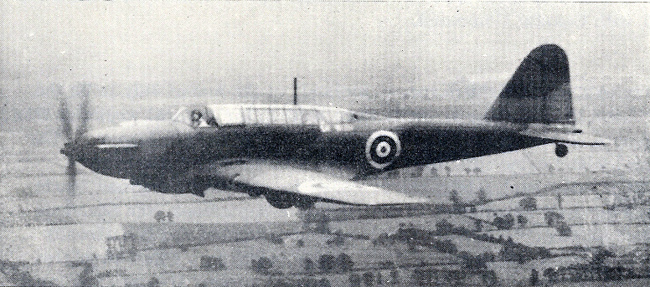
Fairey Battle Mk 1 K 9202 September 1939.
Many of the reformed Squadrons were equipped with the Hind as an interim aircraft
before the arrival of the Blenheims and Battles. 98 were to re-equip with the Fairey
Battle which arrived in June 1938. Although a great advance over the Hawker biplanes
which it replaced, the Battle was to prove underpowered and under-armed.
In April, 1939, the Squadron was affiliated to the city of Derby under the Air
Ministry Municipal Liaison scheme and on 26th April 1939 the Mayor of Derby visited the
Squadron at RAF Hucknall. On 17th June 1939, a formation fly-past was made at the
official opening of Derby Airport.
"3rd September 1939. At 11. 00 today it was announced that the UNITED KINGDOM
was at war with GERMANY. The squadron not being a mobilizing unit remained at its
parent station". So the F. 540, the Operations Record Book, starts the war.

98 Sqn personnel at Hucknall - September 1939 (Thanks to James Robinson.)
During the following months of the "phoney war", the Squadron continued its
normal flying training, but as the diarist reports "has been in a state of flux".
On 16th April 1940, the Squadron went to France, to Nantes/Bougon, just 22 years to
the month since last going to France. During the next two months, the Squadron con-
tinued its role of receiving aircrews from England, completing their training and
sending them off to their operational squadrons. At the beginning of June 1940, the
Squadron was ordered to return to the UK and continue its work from a home station.
On Sunday, 17th June 1940, the remaining Squadron personnel of fourteen officers and
two hundred and thirty other ranks left St Nazaire harbour on the SS Lancastria, Soon
after leaving harbour, the ship was bombed by a Ju 88 and sank within twenty-five
minutes; about 2,500 soldiers and airmen perished, half the number on board. 98
Squadron lost seventy-five airmen and probably another fifteen, who were reported
missing.
The Squadron was re-assembled at Lossiemouth in Scotland and then Gatwick. At
first it seemed as if 98 would be disbanded but news came that it would be retained for
new duties in Iceland, with Coastal Command.
Iceland
The advance party arrived at Kaldadarness, Iceland, at the end of July 1940 to be the
first RAF unit to be based there. The aircraft were held up for several weeks at Wick
waiting for the weather to clear, but eventually began to arrive on 27th August 1940. The
awe-inspiring view as Iceland came into sight was met with very glad eyes, as
Wg Cdr Ashton recalled, after such a long sea crossing for the single engined Battles.
By the time the remaining aircraft arrived in the middle of September 1940, the Squadron
was as well established as possible in their new harsh environment and had already
carried out some shipping reconnaissance sorties. The Squadron's roles were also
to defend the island from enemy attack, to carry out patrols against U-boats and later
to escort convoys. Flights were detached to small airstrips to the north at
Melgerdi and Akureyri.
With the improvement of the weather in the spring of 1941, the Squadron was able
to take a more active part in the war. On 29th March 1941, Sgt Talbot sighted a U-boat at
periscope depth and dropped a 250lb bomb. The U--boat was not seen again. This
appears to have been the first time 98 Squadron engaged the enemy in the Second World
War.
On 8th June 1941 Plt Off Dyer took off to search for the German battleship 'Bismarck'
and the 'Prinz Eugen'. The weather was bad though and he had to land at Reykjavik.
That day also saw the arrival of the first Hurricanes which had been shipped over, and
the following day the Battles were classed as non-operational. However, the Battles
had not quite finished. Pit Off Dyer, on patrol in the evening, sighted and attacked a
U-boat that appeared to be surfacing. The air gunner stated that the U-boat's bows
were almost vertical after the bomb had burst.
No 98 Squadron's days were numbered though, and as the Hurricane flight began to
operate independently towards the end of July 1941, the Battles were flown to Reykjavik and
dismantled ready for shipping to Canada. The Squadron officially disbanded on
15th July 1941.
The Bombing of Europe.
The Squadron came into being again on 12th September, 1942, at West Raynham in
2 Group of Bomber Command. The following week the first aircraft, the North
American Mitchell, began to arrive being the first in RAF service. The next month
98 moved to Foulsham a few miles further east, and settled down to some concentrated
training. By December 1942 the Squadron was operational but due to troubles with the gun
turrets were confined to air-sea rescue searches.
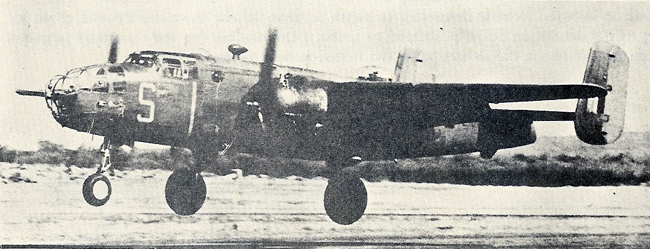
Mitchell Mk 2 FL 704 1943
North American B-25 Mitchell
One of the most important US tactical warplanes of World War II, the North American B-25 Mitchell
flew for the first time in January 1939. On 16Apr42, the Mitchell leapt into the headlines when
the aircraft carrier USS Hornet, from a position at sea 1,075 Km (668 miles) from Tokyo, launched
16 B-25Bs of the 17th AAF Air Group, led by Lt Col J. H. Doolittle, for the first attack on the
Japanese homeland. USAAF Mitchells operated effectively against Japanese forces in New Guinea,
carrying out low-level strafing attacks in the wake of Allied bombing operations. The B-25B was
followed into service by the virtually identical B-25C and B-25D. The two variants were used in most
theatres of war, and 533 B-25C/D aircraft were delivered to the RAF as Mitchell Mk.IIs to
supplement and earlier delivery of 23 Mitchell Mk I (B-25B) aircraft.
The dedicated anti-shipping version of the Mitchell was the B-25G, 40 of which were produced.
Developed for use in the Pacific theatre, the B-25G had a four-man crew and was fitted with a 75 mm
(2.95 in) M4 gun in the nose, adding to its already powerful nose armament of four 12.7 mm (0.50 in)
guns. The follow-on variant, the B-25H (1,000 built) had a lighter 75 mm (2.95 in) gun. The 4,318
examples of the next variant, the B-25J, featured either a glazed B-25D nose or, in later aircraft, a
'solid' nose with eight 12.7 mm (0.50 in) machine guns. The RAF took deliveries of 313 B-25Js as the
Mitchell III, and 458 B-25Js were transferred to the US Navy from 1943, these aircraft being designated
PBJ-1H. The Soviet Union also took delivery of 862 Mitchells under Lend-Lease, and surplus B-25s were
widely exported after World War II.
Specifications apply to the North American B-25D Mitchell: Crew: 5; Powerplant: 1,268 Kw (1,700 hp)
Wright R-2600-13 18-cylinder two-row radial engines; Performance: max speed 457 Km/h (284 mph);
range 2,454 Km (1,525 miles); service ceiling 6,460 m (21,200 ft); Dimensions: wingspan 20.60 m
(67 ft 7 in) length 16.13 m (52 ft 11 in); height 4.82 m (15 ft 10 in); Weight: 18,960 Kg (41,800 lb)
loaded. Armament: six 12.7 mm (0.50 in) machine guns; internal and external bomb/torpedo load of
1,361 Kg (3,000 lb). (Thanks to The Encyclopaedia of Aircraft editied by Robert Jackson).
The first bombing raid was on 22nd January 1943, when six Mitchells took off to
bomb the oil installations at Terneuzen, Ghent. Five got through to the target one
having to return after striking a seagull and being blinded when the perspex shattered.
Only four returned, Plt Off Woods and his crew in FL 693 were hit by flak and crashed
over the target, all presumed killed.
The next three months were occupied in training exercises and ASR whilst modifi-
cations were being carried out on the gun turrets, but 98 was back in business on
13th May 1943 when six aircraft successfully bombed the marshalling yards at Boulogne,
but one aircraft failed to return. In the months to come, the Squadron was to be
increasingly active carrying out raids on airfields and installations at Brest, Rotterdam,
Flushing, Ghent, and many other targets in the north of France and the Low Countries.
In August 1943 the Squadron moved to Dunsfold, Surrey and continued operations from
there. Operating usually in two boxes of six aircraft, bombing was carried out
between 10,000' and 14,000' dropping mostly 500 lb bombs but also 1,000 lb and 250 lb.
"No-Ball" Targets
On 23rd December 1943, attacks on "No-Ball" targets commenced. Although it
was not known at the time, these were the V1 flying bomb sites and, located along the
French and Belgium coasts, were to be bombed by the Squadron until May 1944.
During this time the first Gee sets were installed in the Mitchells. At the end of
March 1944 the Squadron detached to Swanton Morley, Norfolk, for two weeks for an army
exercise and further training.
1st May 1944, the Squadron's targets changed back to the marshalling yards and
airfields in preparation for the Second Front. The marshalling yards at Cambrai
were again attacked, just twenty-six years after the Squadron first bombed them in
the First World War. The old belief that bombs never fall twice in the same place is
effectively disproved by comparing the 1918 photograph with that of 1944. The
Squadron seemed to have been sent to bomb targets up and down the French coast as
part of the deception being practiced to make it impossible for the Germans to guess
which sector of the coast was to be the invasion beach-head.
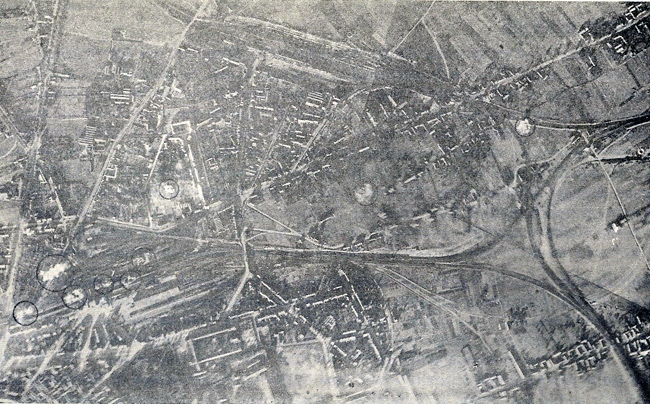
Above Bombing of the marshalling yards at Cambrai 3rd September 1918. Eighteen
112-lb bombs were dropped from 12,500 ft.
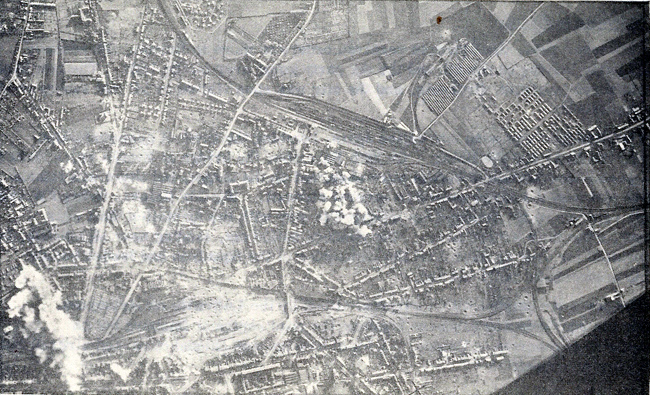
The same marshalling yards being bombed on 5th May 1944 from 10,000 ft. Attack
led by Wg Cdr Lynn, twelve Mitchells dropping 500 and. 1,000lb bombs.
The Invasion of Europe
On 5th June 1944 a strict security clamp was imposed at Dunsfold and that evening
eleven aircraft went off to bomb individually, a unique event, targets in the Caen area.
The next morning it was announced that British and American airborne and seaborne
divisions had landed at points between Le Havre and Cape Barfleur on the Cherbourg
Peninsular. That evening fifteen aircraft took off to bomb the Caen area and the next
night, D+2, seventeen Mitchells attacked rail targets at Vire and Flers. The next few
weeks the Squadron carried out night raids on Second Front targets and on 20th June 1944
resumed daylight sorties on the "No-Ball" sites. The heavily defended steel-works at
Caen were attacked on 22nd June 1944 when our forward troops were just 1,000 yds away,
each of the eighteen aircraft carrying eight 500 lb bombs. Naturally extreme
accuracy was essential and photographs showed the steel works enveloped in smoke.
During July 1944 more daylight raids were flown, mostly against fuel and ammunition
dumps. On the 23rd July 1944 fifteen aircraft, led by Wg Cdr Paul took off to bomb the railway
yard at Glos-Montfort. The target was bombed on Gee-H from 10,000' over 10/10ths
cloud with 500 lb bombs. There was no flak, but on releasing their bombs "S" FV 985
blew up, setting fire to and destroying "R" FW 122, killing all the crews. "G" FL 186
was so badly damaged that it had to crash land in the American sector of Normandy and
"H" FV 931 had to force land at Tangmere. Apart from such disasters, losses were
from flak, the occasional Fw 190 and at least one from a hang-up bomb which released
on landing back at Dunsfold.
The Squadron in Europe
In October 1944, the Squadron received orders to move to Europe, the advance
ground party leaving on the 9th Oct 1944 and the air party going over on the 18th Octpber 1944. The new base
was Melsbroek airfield, Brussels, and the city was soon visited by all and sundry at the
first opportunity.
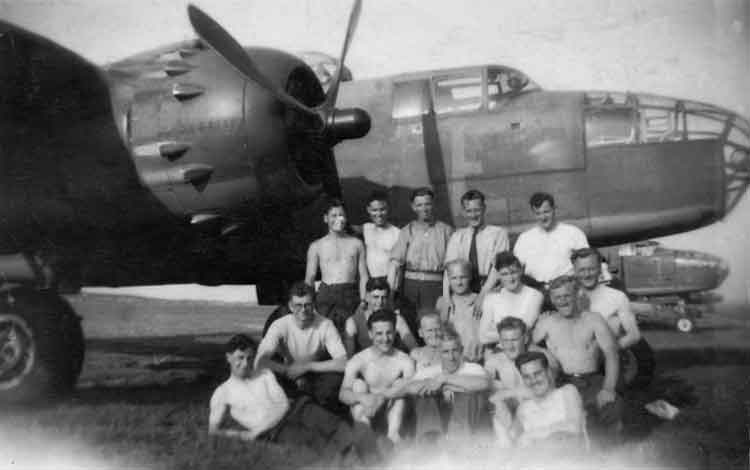 98 Squadron B-25 Mitchells believed to be at Melsbroek, Belgium some time from 17Sep45 to 14Mar46.
Nick's father Henry Richardson is the last one on the right in the middle row. (Thanks to Nick Richardson.)
The Squadron was soon into action again, bombing the lanes of communication
between the Maas and the Rhine. On 29th November 1944 the bridge at Zwolle was attacked
and a good concentration of bombs were observed on the target, but there was intense
AA fire and minor damage caused to several aircraft. Wg Cdr Hamer, flying FW 192,
had his controls badly damaged but managed to stay with the formation until over
Arnhem, when hit a second time. The gunners bailed out, landing near Melsbroek, he
then orbited for over an hour until the remainder of the Squadron had landed before
making a successful belly landing.
The New Year 1945 started with a surprise attack by the Luftwaffe on Melsbroek.
Luckily the Squadron was airborne bombing the road centre at Dasburg but on
returning were diverted to Epinoy. A lot of damage was caused to parked aircraft but
there were no casualties.
In February 1945 255 operational sorties were flown totaling 521 hours; 1,796 five-
hundred pounders and sixteen 1,000 lb bombs dropped. Four DFCs were awarded to
Fg Offs J. R. MacDonald, G. Colbourn, J. W. Morton and Pit Off J. W. Williams.
A/Sqn Ldr C. A. H. Beck received a bar to his DFC.
March 1945 saw the Squadron even more busy in the tactical bombing of mostly
marshalling yards, but as the weeks passed and V-E Day approached the effort declined.
At the end of April 1945 the Squadron started to move into Germany, to its new airfield,
Achmer near Osnabruck, the Mitchells flying over on the 30th April 1945.
On 2nd May 1945, the Squadron carried out its last operation of the war when six
Mitchells took off to bomb the rail centre at Itzehoe. Attacking from 10,000' the bombs
were seen to fall on the track. No opposition was met and all crews returned safely.
The next few months saw the Squadron engaged in mostly ferrying duties and con-
ducted tours over the Ruhr. The Mitchells, supplied under Lend-Lease, were slowly
withdrawn and personnel not converting onto the Squadron's new aircraft, the
Mosquito, were ferried home.
98 Squadron B-25 Mitchells believed to be at Melsbroek, Belgium some time from 17Sep45 to 14Mar46.
Nick's father Henry Richardson is the last one on the right in the middle row. (Thanks to Nick Richardson.)
The Squadron was soon into action again, bombing the lanes of communication
between the Maas and the Rhine. On 29th November 1944 the bridge at Zwolle was attacked
and a good concentration of bombs were observed on the target, but there was intense
AA fire and minor damage caused to several aircraft. Wg Cdr Hamer, flying FW 192,
had his controls badly damaged but managed to stay with the formation until over
Arnhem, when hit a second time. The gunners bailed out, landing near Melsbroek, he
then orbited for over an hour until the remainder of the Squadron had landed before
making a successful belly landing.
The New Year 1945 started with a surprise attack by the Luftwaffe on Melsbroek.
Luckily the Squadron was airborne bombing the road centre at Dasburg but on
returning were diverted to Epinoy. A lot of damage was caused to parked aircraft but
there were no casualties.
In February 1945 255 operational sorties were flown totaling 521 hours; 1,796 five-
hundred pounders and sixteen 1,000 lb bombs dropped. Four DFCs were awarded to
Fg Offs J. R. MacDonald, G. Colbourn, J. W. Morton and Pit Off J. W. Williams.
A/Sqn Ldr C. A. H. Beck received a bar to his DFC.
March 1945 saw the Squadron even more busy in the tactical bombing of mostly
marshalling yards, but as the weeks passed and V-E Day approached the effort declined.
At the end of April 1945 the Squadron started to move into Germany, to its new airfield,
Achmer near Osnabruck, the Mitchells flying over on the 30th April 1945.
On 2nd May 1945, the Squadron carried out its last operation of the war when six
Mitchells took off to bomb the rail centre at Itzehoe. Attacking from 10,000' the bombs
were seen to fall on the track. No opposition was met and all crews returned safely.
The next few months saw the Squadron engaged in mostly ferrying duties and con-
ducted tours over the Ruhr. The Mitchells, supplied under Lend-Lease, were slowly
withdrawn and personnel not converting onto the Squadron's new aircraft, the
Mosquito, were ferried home.
THE POST-WAR PERIOD
On 17th September 1945, the Squadron moved back to Melsbroek, a happy move,
with the delights of Brussels near-by. The end of the month saw the last of the
redundant aircrew returned to England and a few days later the first new crews arrived
with the Mosquito XVIBs. Training flights occupied the Squadron for the following
months though it did have the job of ferrying the reports of the Nuremburg war crimes
trial between Nuremburg and Blackbushe.
The end of February 1946 the Squadron advance party set off for the Squadron's new
home in Germany, to Wahn, near Cologne. The Squadron was to remain in Germany
for the next eleven years. Training carried on, the Mosquitos bombing at Haltern.
Ferrying of the trial reports continued, and there were also the daily met. flights
which kept the few serviceable fully occupied. The Squadron was now a much smaller
unit than it had been during the war. There were 16 officers and 17 SNCO aircrew,
plus 62 other ranks. The Squadron was now doing its own servicing again, where as
during the war, the Mitchells had been serviced by another unit common to all the
squadrons. The end of 1946 saw the Squadron rather thin in numbers due to
demobilisation.
On 1st May 1947, the Squadron transferred from 2 Group to 84 Group, severing a
link that had existed since September 1942. During the summer the following year,
the Mosquito Mk 35 replaced the XVIs. The Squadron also had an Airspeed Oxford
and a Mosquito T3 which were kept busy that winter when the seven Mk 35s were
grounded for faulty injector pumps.
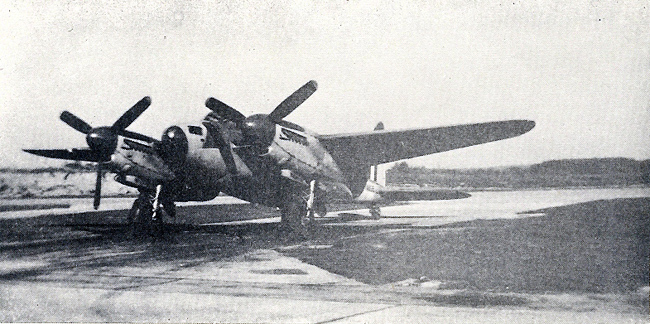
Mosquito T III TA 696 at RAF Wahn 1949
The Squadron moved to Celle on 19th September 1949 and on the 25th September 1949 went to
Orleans/Bricy for a demonstration. The briefing for the demonstration took so long
that at the end everyone was told to put their watches back 30 minutes in order to get
the formation off on time!
Jet Conversion
In November 1950 the Squadron moved from Celle to Fassberg and were told early
in the new year 1951 that they were to be re-equipped with the Vampire FB 5. During
February 1951 the Mosquitos began to leave and a Meteor Mk 7 started giving the pilots the
conversion to jets. The Squadron was now no longer a bomber squadron, which it had
been since the days of the DH 9s, but now a ground-attack squadron with only pilots as
the aircrew.
With training well under way, the Squadron became very active in various tactical
exercises and many detachments were made, probably the most enjoyable being the
ones to the Air Firing Camp at Sylt, especially in the summer months.
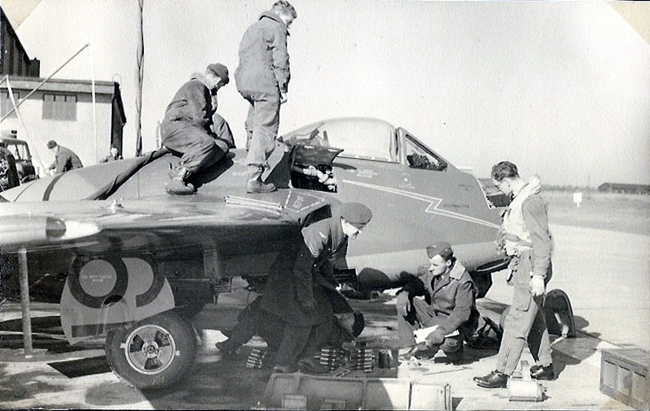
Fg Off G. C. Chapman watching arming-up Vampire B 5 WA 346 at A.F.C. Sylt 1953.
Photo by B. B. Sharman
During August 1953 the Squadron re-equipped with Venom FB 1s and the command
of the Squadron taken over by Sqn Ldr Smith-Carington, AFC, who had been on the
Squadron during the war in the Mitchell and Mosquito days. A few months later the
Venoms were temporarily grounded with engine troubles and also restricted for high
'G' manoeuvres until they had been modified and strengthened.
In March 1955 the Squadron moved to Jever and re-equipped with the Hawker
Hunter Mk 4 being the first Hunter squadron in 2nd TAF.
As with most new aircraft, the Hunter had its fair share of snags mostly hydraulic
and electrical and Rolls Royce also found difficulty in keeping the supply of spare engines
going. The problem was not helped by the shortage of ground-crew on the Squadron.
Despite this, the Squadron's efficiency improved as shown by the results of the firing
carried out at Sylt.
Morale on the Squadron was high. The bowler hats and umbrellas sported by the
aircrew soon became a well known feature of the Squadron. The Squadron once won, at
Celle, a new member that answered to the name 'Elspeth', and was called a pig by those
that knew no better. She was voted in as a mess member with strict orders that she
was not to be eaten. She made her sacrifice when the Squadron moved to Jever contri-
buting to the bill the Squadron had for repairs to the hangar it occupied. The Squadron
also appeared in the cartoon "Jeff Hawke" by Sydney Jordan which is featured in the
"Daily Express". Mr. Jordan personally knew some Squadron members and he would
at times include them and the Squadron crest in his sketches.
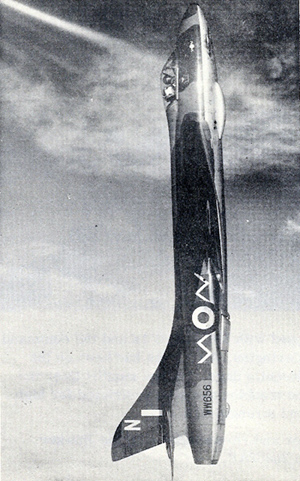
The photograph shows the new Squadron
markings of a white zig-zag on a red back-
ground. This was first officially sported by
the Hunters being a combination of a white
flash worn by the DH 9s in 1918 and red
markings used by the Mosquitos.
Powered by the Rolls-Royce Avon
giving 8,050 lb thrust the Hunter was armed
with four 30-mm Aden cannon.
Hunter F 4 WW 656
Photo: B. B. Sharman
Alas, the idea of the manned fighter was
becoming old--fashioned, and 98s days were
numbered. Along with other fine fighter
squadrons in 2nd TAF, the Squadron was to
disband and in July 1957 the Hunters were
dispatched to the UK and by the 25th July 1957 all the
aircrew and groundcrew had dispersed.
Ballistic Missiles
In December 1958 RAF personnel went over to the USA to train for the Douglas
'Thor' Intermediate Range Ballistic Missile. Training culminated at Vandenberg,
California, when on 18th April, 1959, Sqn Ldr Coulson and his crew became the first
RAF crew to launch a ballistic missile.
At Driffield, on 1st November 1959, No 98 Squadron was officially reformed with
Sqn Ldr Coulson commanding. Douglas Aircraft Company had installed the missiles
during the previous months and the three missiles were in position on their pads and
handed over in October 1959.
A lot of pioneering work in administration and training was carried out by the
Squadron in the following months as they were the first squadron to be fully equipped.
On 7th June 1960, 98 had their first operationally ready missile, the first 'Thor' in the
RAF to achieve this. During the following year, a record of 413 countdowns was
established, a rate achieved by no other squadron in the Thor force.
In the autumn of 1962, just when a new programme of modifications was to be
introduced, it was announced that the Thor Force would be disbanded in the New Year 1963.
On 30th March 1963, the Squadron was open to all past members, the Mayor of Derby
attended and the Squadron Association held a Farewell Dinner.
The next day all warheads were removed and all three missiles de-mated from the
launching pads and the dismantling teams moved in. On 18th April 1963 the Squadron was
officially disbanded.
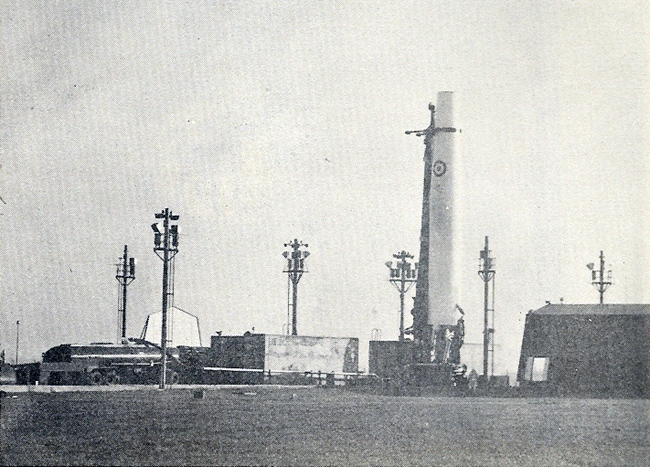
Douglas 'Thor' Intermediate Range Ballistic Missile in state of readiness
at RAF Driffield 1960
Canberras of Signals Command
As the Thor squadron ceased to exist at Driffield, so No 245 Squadron, based at
Tangmere, found itself suddenly turned into No 98 Squadron. The Squadron, in Signals
Command, operated the English Electric Canberra B. 2 a light bomber but now being
used for calibrating and flight checking various ground radars.
At this time, the Squadron was involved in Operation "Energise" in which aircraft
were detached to various NATO countries. The Squadron establishment had been
increased for this from the normal number of twelve aircraft and crews up to eighteen,
a crew consisting of one pilot and one navigator.
During July 1963, the Squadron heard that Tangmere was to close and that they
were to move to Watton in Norfolk. This was a sad blow as Tangmere was a very
pleasant station being only a few miles from the south coast. The move took place in
September 1963 and on the 20th September 1963 the aircraft were flown up. Meanwhile, the Energise
detachment having finished in Cyprus and Turkey moved on to Greece, to Larissa, and
then in November 1963 to Aviano in Italy. In February 1964 the detachment returned to
Watton and the Squadron returned to its normal strength. There were no ground-crew
on the Squadron the servicing being carried out by the centralised servicing of Tech
Wing.
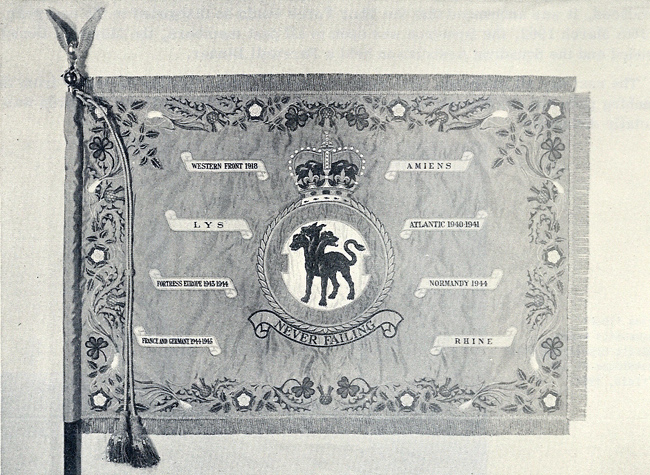
No 98 Squadron Standard
On 30th September, 1966, No 98 Squadron received its Standard along with the
other two squadrons based at Watton, Nos 97 and 115 Squadrons. Air Chief Marshal
the Earl of Bandon making the presentation.
The 50th Anniversary of No 98 Squadron celebrated on Saturday, 2nd September 1967
with an exhibition of the Squadron's past and present activities and a Ball, held in the
station NAAFI, attended by many former Squadron members.
-*-*-*-*-*-*-*-*-*-*-*-
The future is unknown. Only time will tell how long the Standard of No 98
Squadron will remain flying.
APPENDIX 'A'
OFFICERS COMMANDING NO 98 SQUADRON
First World War
Lieut D. V. D. Marshall 30 Aug 17
Major E. L. M. Gower 21 Sep 17
Capt E. A. B. Rice 14 Dec 17
Capt R. G. Gould 19 Dec 17
Capt E. A. B. Rice 18 Jan 18
Major H. MacD. O'Malley 19 Feb 18
Major E. T. Newton-Clare 5 Jun 18
Major P. C. Sherren 26 Aug 18
Disbanded 24 Jun 19
Second World War and Germany
Sqn Ldr P. J. A. Hume-Wright 21 Sep 36
Sqn Ldr R. H. Donkin 3 Aug 37
Wg Cdr F. W. Dixon-Wright 6 Sep 39
Wg Cdr D. F. Anderson, DFC, AFC 11 Oct 39
Wg Cdr G. R. Ashton, AFC 25 Mar 40
Fit Lt H. C. G. Wilcox 31 Mar 41
Disbanded 15 Jul 41
Wg Cdr L. A. Lewer 12 Sep 42
Wg Cdr A. M. Phillips 18 Aug 43
Wg Cdr R. K. F. Bell-Irving 9 Apr 44
Wg Cdr J. G. C. Paul, DFC 15 May 44
Wg Cdr L. G. Hamer 16 Sep 44
Wg Cdr K. Gray 16 Jan 45
Wg Cdr V. E. Marshal 28 Feb 45
Wg Cdr E. W. Thornewill 9 Feb 46
Wg Cdr D. B. Gericke 12 Feb 47
Sqn Ldr P. W. Cook 5 Nov 47
Sqn Ldr D. R. M. Frostick 25 Jul 49
Sqn Ldr J. M. Rumsey 29 Aug 50
Sqn Ldr A. S. R. Strudwick, DFC 15 Mar 51
Sqn Ldr J. H. Smith-Carington, AFC 31 Aug 53
Sqn Ldr D. Adamson 10 Dec 55
Disbanded 29 Jun 57
Thor Missile Squadron
Sqn Ldr P. G. Coulson, MBE, AFC Sep 59
Sqn Ldr S. Hudson May 61
Canberras
Sqn Ldr A. Musker 19 Apr 63
Sqn Ldr P. W. Shaw 17 Aug 64
Sqn Ldr L. J. Wright 10 Oct 66
Sqn Ldr A. E. Sadler 16 Jan 67
APPENDIX 'B'
SQUADRON LOCATIONS
First World War
Harlaxton, Lincs 30 Aug 17
Old Sarum, Wilts 31 Aug 17
Lympne, Kent 1 Mar 18
St Omer, France 1 Apr 18
Clairmarais 3 Apr 18
Alquines 13 Apr 18
Coudekerque 25 May 18
Ruisseauville 6 Jun 18
Drionville 21 Jun 18
Chailly 14 Jul 18
Blangermont 3 Aug 18
Abscon 27 Oct 18
Marquain 27 Dec 18
Alquines 19 Jan 19
Shotwick, Cheshire 20 Mar 19
Disbanded 24 Jun 19
Second World War
Abingdon, Berks 17 Feb 36
Hucknall, Notts 21 Aug 36
Scampton, Lincs 10 Mar 38
Hucknall, Notts 15 Sep 38
Scampton, Lincs 7 Mar 40
Finningley, Yorks 25 Mar 40
Nantes/Chateau Bougon, France 19 Apr 40
Gatwick, Surrey 10 Jun 40
Kaldadarness, Iceland 31 Jul 40
Disbanded 15 Jul 41
West Raynham, Norfolk 12 Sep 42
Foulsham, Norfolk 15 Oct 42
Dunsfold, Surrey 18 Aug 43
Swanton Morley, Norfolk 26 Mar 44
Dunsfold, Surrey 10 Apr 44
Brussels/Melsbroek, Belgium 16 Oct 44
Osnabruck/Achmer, Germany 30 Apr 45
Post War Years
Brussels/Melsbroek, Belgium 17 Sep 45
Wahn, Koln, Germany 15 Mar 46
Celle, Germany 17 Sep 49
Fassberg, Germany 1 Nov 50
Jever, Germany 19 Mar 55
Disbanded 15 Jul 57
Driffield, Yorks Sep 59
Tangmere, Sussex 19 Apr 63
Watton, Norfolk 1 Oct 63
Cottesmore, Rutland Apr 69
Disbanded 27 Feb 76
APPENDIX 'C'
SQUADRON AIRCRAFT TYPES
From To Main Type Support Type
Aug 19 Mar 18 DH 4 Armstrong Whitworth FK 8
BE 2c
BE 2e
Sopwith Scout
Avro 504
Feb 18 Jun 19 DH 9 Sopwith Camel
Jan 19 Jun 19 DH 4 (Ferrying)
Feb 36 Sep 38 Hawker Hind
Jun 38 Jun 41 Fairey Battle Mk 1 Avro Anson Mk 1
Oct 42 Sep 45 N. Amer. Mitchell Mk 2
Sep 44 Sep 45 N. Amer. Mitchell Mk 3
Nov 45 Aug 48 de H. Mosquito Mk 16B Airspeed Oxford
Mosquito T 3
Aug 48 Mar 51 de H. Mosquito Mk 35 Mosquito T 3
Feb 51 Aug 53 de H. Vampire FB 5 Meteor T 7
Aug 53 Mar 55 de H. Venom FB 1. Vampire T 11
Meteor T 7
Mar 55 Jul 57 Hawker Hunter F 4 Vampire T 11
Sep 59 Mar 63 Douglas "Thor' IRBM
Apr 63 ? E.E. Canberra B 2 Canberra. T 4
APPENDIX 'D'
AIRCRAFT USED BY 98 SQUADRON
De Havilland DH 9
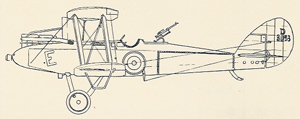
Dimensions
Span . . . . . . . 42 ft 4 ins
Length . . . . . . 30 ft 6 ins
Height . . . . . . 11 ft 2 ins
Armament:
One fixed 0.303" Vickers gun
One 0.303" Lewis gun on
Scarff ring, two 230-lb bombs
below fuselage or alternative
weights below wings.
Some typical Squadron aircraft
serial numbers:
C6062, C6060, C6079,
C6084, D5571, D7224 'H'
Hawker Hind
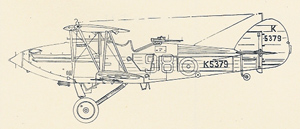
Dimensions:
Span . . . . . . . 37 ft 3 ins
Length . . . . . . 29 ft 7 ins
Height . . . . . . 10 ft 5 ins
Armament:
One fixed 0. 303" Vickers
Mk III gun, one 0.303" Lewis
gun on Hawker-Scarff mounting,
up to eight 20-lb bombs below
wings.
Some typical squadron aircraft
serial numbers:
K5369, K6717, K6721,
K5379, K5381, K5380

Fairey Battle Mk 1
Dimensions: Armament: Some typical squadron
aircraft serial numbers:
Span . . . 54 ft 0 ins One fixed 0.303" Browning gun,
Length . . 52 ft 1 ¾ ins One Vickers 0. 303" 'K' gun, K9238, L5343, L5331,
Height . . 15 ft 6 ins four 250-lb GP bombs plus an K9199, P6570, P2330
overload of 500-lb weight of bombs.

North American 'Mitchell' Mk 2 (B-25 D)
Dimensions: Armament: Some typical squadron
aircraft serial numbers
Span . . . 67 ft 6 ins One 0. 5" nose gun, two 0.5" in
Length . . 52 ft 10 ins upper turret, two O. 5" in lower Fw189 'VO.A', Fl176
Height . . 15 ft 9 ins turret, 2000-lb bomb load VO. B', FL 693'VO.O',
Fl204 'VO.C', Fl197
'VO.G', Fl698 'VO.K'.

De Havilland Mosquito Mk B XVI
Dimensions: Armament: Some typical squadron
aircraft serial numbers:
Span . . . 54 ft 2 ins One 4000-lb bomb internally or
Length . . 40 ft 6 ins four 500-1b bombs internally and Rv340 'VO.M', Ml981,
Height . . 12 ft 6 ins two 500-lb bombs externally Rv362 'VO.C', Mm185
'VO.E', Pf596,'VO. T',
Pf545 'VO. Z'.
De Havilland Vampire FB 5

Dimensions:
Span . . . 38 ft 0 ins
Length . . 30 ft 9 ins
Height . . 8 ft 10 ins
Armament :
Four 20 mm Hispano Some typical squadron aircraft serial numbers: Wg832 'F',
guns Wa417 'L.G', Wg844 'L.L', Wa203 'L, P', Wa346 'L. S'.
Venom Fb.1 Serial numbers: We377 'L. S', We380 'L.B',
We368 'L. N'.

Hawker Hunter Mk 4
Dimensions: Armament: Some typical squadron
Span . . 33 ft 8 ins Four 30 mm Aden guns aircraft serial numbers:
Length . 45 ft 10½ ins Wt351, Ww653, Ww654,
Height . 13 ft 2 ins Wt742 'A', Ww658 '0',
Wt743 'R', Ww655 'M''.


Douglas 'Thor' IRBM
Dimensions Length . . . . 65 ft
Diameter. . . . 8 ft
_______________________________
English Electric Canberra Mk B. 2
Dimensions:
Span. . . .63 ft 11½ ins
Length . . 65 ft 6 ins
Height . . 15 ft 8 ins
Armament:
Nil
Some typical squadron aircraft
Serial numbers:
Wh869, Wj681, Wk144, Wj719,
Wj603 'K', Wd955, Wh913
APPENDIX 'E'
MAPS OF THEATRE OF OPERATIONS - WORLD WAR I
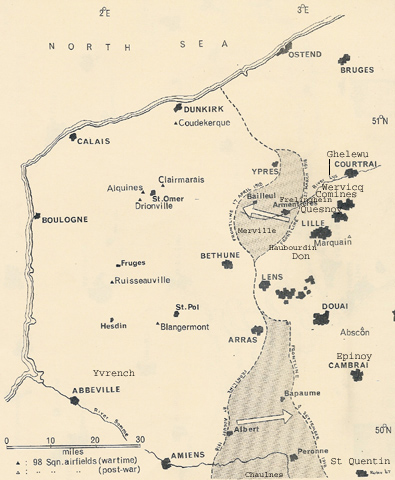
Map 1: World War I Sites
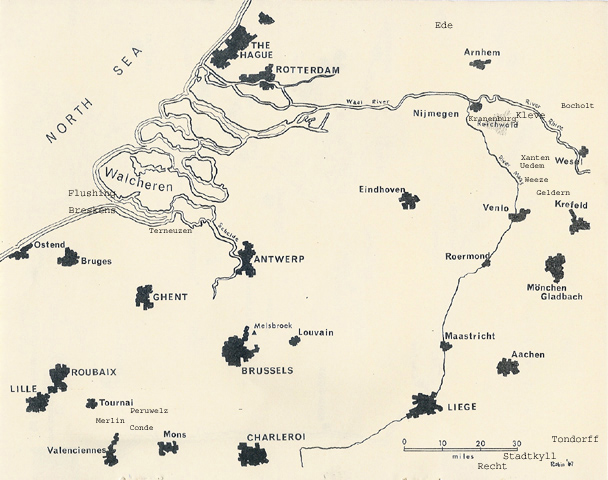
Map 2: World War II Sites
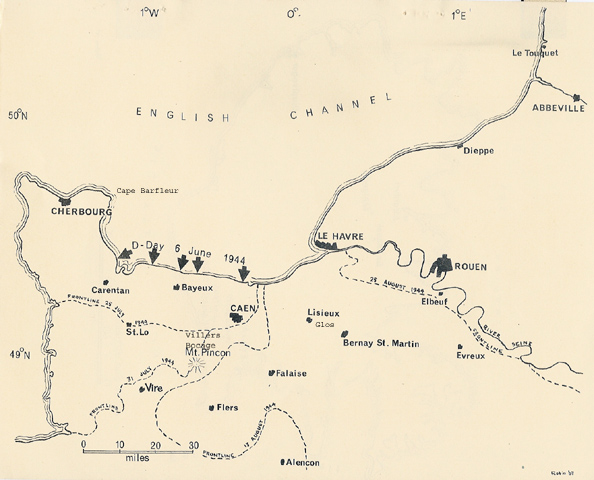
Map 3: World War II D-Day Invasion Sites
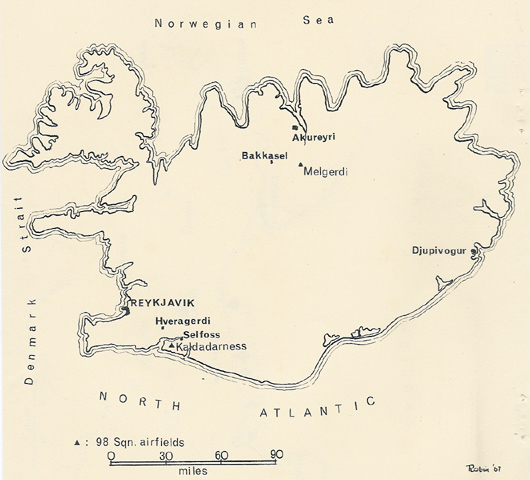
Map 4: World War II Icelandic Sites
|







